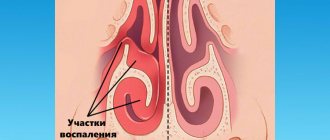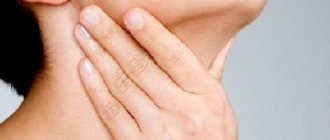Vasomotor rhinitis is an inflammatory process of the nasal mucosa. In a healthy state, the vessels are able to control the volume of air, changing their size due to filling with blood. When bacteria, viruses, microbes, allergens and other foreign bodies enter the body from the outside, the tissue of the shells increases and, as a result, the nasal cavity narrows. In addition, an edematous-secretory reaction is caused by an increase in the excitability of the peripheral parts of the autonomic nervous system (ANS).
Vasomotor rhinitis occurs in people of all ages. It affects more than 10% of residents of megacities. A third of patients experience severe signs of the disease at regular intervals. The average age of patients is 35-45 years. According to statistics, women are twice as likely as men to suffer from vasomotor rhinitis. Treatment should begin after diagnosis. Due to the fact that the disease develops slowly, there is usually no rush to eliminate its symptoms. As a result, it begins to progress and complications appear.
- Patient examination
- Drug therapy
Forms of the disease
Vasomotor rhinitis is of two types: allergic and neurovegetative.
Allergic rhinitis
Allergic rhinitis is a disruption in the blood circulation process that occurs under the influence of allergens, as well as other irritating factors.
The moment they enter the body, an allergic reaction begins, which can be specific or nonspecific. The specific reaction has three stages:
- immunological (production of antibodies),
- the emergence of mediators,
- pathophysiological (inflammatory process).
The symptoms of a nonspecific reaction are caused by close contact with the allergen.
The disease can manifest itself in a seasonal or year-round form. In the first case, the violation is short-term in nature and does not require a prompt response. In the second case, the patient needs to identify the type of allergen using tests. Treatment of vasomotor allergic rhinitis involves the use of antihistamines.
Neurovegetative rhinitis
Neurovegetative rhinitis is a disorder that occurs due to improper filling of the nasal cavity with blood.
It usually develops in people with ANS diseases or under the influence of such external factors:
- aggressive resins,
- dust,
- irritating odors.
Seasonality does not play a role in this case. The main symptom is a runny nose, which appears in the first half of the day and goes away in the evening. Symptoms and treatment of vasomotor rhinitis of the neurovegetative form are determined by an otolaryngologist and a neurologist.
We treat from a young age
Very often, people get so used to a constant runny nose that they even stop talking to the doctor about it, and use drops every day, because it’s easier. They come, for example, with ear congestion and are very surprised when you ask them about their nose; they don’t know about the direct dependence. “I'm so used to it. I don’t even know what it means to breathe well through my nose; I haven’t been breathing through my nose since childhood.”
Meanwhile, special attention should be paid to nasal breathing in children. Chronic diseases of the nasopharynx can lead to chronic otitis and hearing loss, which parents pay attention to much later, because with such otitis there is no pain syndrome.
Stages of the disease
As vasomotor rhinitis progresses, it goes through three stages of development:
- First stage. Symptoms are not expressed; the nose becomes blocked when there is an unpleasant odor or when there is a change in temperature.
- Second stage. Inflammation of the mucous membrane begins, and the person is bothered by attacks of itching. Possible development of polyps.
- Third stage. The patient loses his sense of smell, nasal discharge begins, and there is a feeling of mucus in the throat. Immunity decreases.
At risk are people who live in places with high levels of climate humidity, who are predisposed to bad habits and exposure to allergens, as well as those who have unstable hormone levels in the body.
Reasons for appearance
The reasons that contribute to an imbalance in the structure of the inferior turbinate can be physiological, psychological, environmental and pharmacological.
| External factors: | Internal factors: |
|
|
Symptoms of the disease can appear during age-related changes in the body (female, male menopause), bearing a child and breastfeeding. Regular use of medications can also lead to rhinitis:
- antidepressants,
- tranquilizers,
- alpha blockers,
- contraceptives,
- non-steroidal drugs.
In a child, rhinitis may be a consequence of teething. Also, the reason may lie in primary pathologies: tonsillitis, pharyngitis, deviated septum, etc.
Be ready
If you plan to visit an ENT specialist, do not rinse your nose or put drops in before your appointment. This way you will wash away all the “evidence” and blur the real picture of the disease. ENT doctors don’t need to see a perfect nose, they need to understand what exactly is preventing you from breathing and why. In addition, it will not be possible to conduct the study on the same day and you will have to come back again, otherwise the result will be false.
American psychologists, led by Professor Patti Wood, have identified four main types of sneezers.
- Enthusiast - sneezes loudly, with soul. Usually this is a charismatic person who has a strong influence on others. This person has many exciting ideas and can encourage others to bring them to life. He is open to new people and opportunities. A good conversationalist.
- Pedant - tries to sneeze unnoticed, quietly, buried in a handkerchief. For such a person, the most important thing is relationships with others. He tries his best to avoid conflicts. Tolerant, calm, sometimes dependent on other people. A good listener and helper.
- The Thinker sneezes with self-esteem, taking a beautiful handkerchief from his pocket. As a rule, this is a reasonable person. Always thinks about his words and actions. Notices the mistakes of others. He is a broad-minded man who has his own opinion on everything. Likes to read books that make you think. He does all the work independently. He usually rests at home, enjoying his solitude.
- A loner sneezes quickly and loudly. This is, as a rule, a decisive and fast person who demands the same from those around him. Has no habit of relying on others. Leader. A good leader. Doesn't like being used.
Symptoms and signs
The main symptom of vasomotor rhinitis is persistent breathing difficulties. Nasal congestion occurs spontaneously. This usually happens in the morning and while lying down. Breathing disorders are accompanied by sneezing, lacrimation, and the release of clear mucus from the mouth. If the disease is accompanied by a bacterial infection, the discharge becomes yellow and green. Body temperature does not increase with vasomotor rhinitis.
The nose may also become stuffy when the patient changes climate or experiences excessive physical activity.
In addition, the clinical picture includes the following main symptoms:
- spasms in the temples,
- redness of the eyeballs,
- heaviness and swelling in the bridge of the nose,
- uncontrolled release of mucus and saliva,
- decreased quality of odor perception,
- redness of the nasal mucosa.
Among the secondary symptoms:
- decreased performance,
- feeling of weakness,
- unstable mental state,
- nervous disorders,
- loss of appetite,
- bitterness in the mouth,
- decreased immunity,
- dyspnea,
- excessive sweating.
Uncontrolled use of drops for vasomotor rhinitis can cause unexpected attacks of itching in the nose. Insufficient ventilation of the lungs entails a disruption of the blood flow process and, as a result, a deterioration in the body’s oxygen supply. This leads to functional disorders of the ANS.
What can lead to chronic runny nose?
Chronic runny nose is a polyetiological pathology, which means it can be caused by many reasons, such as:
- Anatomical features of the structure of the nasal cavity: congenital and acquired curvatures of the nasal septum, deformation of other anatomical formations.
- Irrational treatment of acute rhinitis, with unauthorized use of various drugs and folk remedies, non-compliance with doctor’s recommendations. This leads to the addition of a secondary bacterial infection with the development of complications in the form of sinusitis and prolonged nasopharyngitis.
- Abuse of local vasoconstrictor drugs for a long time.
- Allergy.
- Disruption of the autonomic nervous system, with a predominance of activity of its parasympathetic component. This is considered as a key pathogenetic mechanism of vasomotor chronic rhinitis.
- Chronic endogenous intoxications and vascular disorders (with renal and liver failure, cardiovascular pathology, diabetes, gout, etc.). Hormonal imbalances are especially highlighted during pregnancy.
Also predisposing to the formation of chronic rhinitis is living in an environmentally unfavorable area, working in conditions of dust and increased air pollution, and smoking. An excess of dust particles in the inhaled air paralyzes the work of the cilia of the epithelium of the nasal cavity, provokes excessive secretion of mucus, and injures the mucous membrane.
Quite rare causes of chronic rhinitis include specific infections if they occur with damage to the tissues of the nose and paranasal sinuses. This could be tuberculosis, syphilis and some other diseases.
Diagnostics
Before starting treatment for vasomotor rhinitis, the disease should be diagnosed.
| The criteria that the doctor uses when interviewing: | Characteristic signs of the patient's condition: |
|
|
The doctor evaluates the medical history to determine the cause and history of rhinitis. At this stage, the presence of other diseases of the nasal cavity should be excluded.
Patient examination
Determining the clinical picture involves an objective examination of the patient. Before determining how to treat chronic vasomotor rhinitis, the otolaryngologist must determine whether:
- difficulty contracting the walls during breathing;
- an increase in the size of the walls of the nasal cavity;
- mucous or watery discharge;
- disturbance of a person’s well-being (weakness, fatigue).
If necessary, an allergist and neurologist are involved in making a diagnosis. At this stage, symptoms of VSD are revealed:
- lowering blood pressure,
- feeling of coldness in the extremities,
- joint and muscle pain,
- high sweating,
- anxious state.
After this, laboratory and clinical research methods are carried out.
Rhinoscopy
Rhinoscopy is an examination of the nasal cavity using auxiliary instruments: a funnel for children and a mirror for adults. In modern conditions, the procedure is carried out using a video camera. The result is displayed on the monitor, which makes it possible to analyze the disease over time.
During anterior rhinoscopy, a mirror is inserted into the hole to a depth of one to two centimeters, after which it opens in the anterior sections of the sinus. This allows you to evaluate the condition of the anterior part of the septum, as well as the overall nasal passage.
Average rhinoscopy involves inserting a speculum below the middle concha. The doctor can see the middle meatus.
During posterior rhinoscopy, the fiberscope is inserted through the oral cavity to the pharynx. This way you can assess the condition of the back of the shell. To prevent the gag reflex, treatment with an anesthetic occurs. Based on the results of rhinoscopy, it is determined how to treat vasomotor rhinitis without surgery.
Laboratory research methods
To know how to cure vasomotor rhinitis, you need to conduct laboratory diagnostics:
- A general and biochemical blood test allows you to see the number of eosinophils.
- Allergy tests:
- skin allergy tests - when the pathogen comes into contact with the skin, an allergic reaction occurs;
- assessment of immunoglobulin G to the pathogen involves a laboratory analysis of blood serum using a special tablet.
- An immunogram allows you to assess the quality of the immune system.
- Culture analysis of nasal discharge excludes the presence of an additional infection (rhinitis, sinusitis).
- An x-ray shows a change in the color of the maxillary sinuses and the presence of polyp formation.
The list of additional diagnostic methods includes an electrocardiogram and an electroencephalogram.
Treatment
Treatment of both initial and chronic forms of vasomotor rhinitis is not an easy process.
Complex therapy includes:
- taking measures to protect against infection,
- normalization of lifestyle and recreation,
- correction of diet,
- rejection of bad habits,
- drug treatment,
- physiotherapeutic procedures,
- surgical intervention.
The set of measures depends on the form of the disease, the age of the patient, as well as the presence of other disorders in the body. Treatment of vasomotor rhinitis is carried out at home or in a hospital.
Drug therapy
The goal of drug therapy is to eliminate the symptoms of the disease with further relief of the patient’s condition. To do this, the otolaryngologist may prescribe:
- Antihistamines 2 and 3 generations. They eliminate signs of allergies and fight viral pathogens.
- Medicines that constrict blood vessels. Thanks to the reduced size of the vessels, free breathing is restored.
- Preparations based on corticosteroid hormones. They eliminate the inflammatory process and improve the functioning of the immune system.
Additionally, M-cholinergic receptor blockers and cell membrane stabilizers are prescribed. We recommend asking your doctor what drops you can use for vasomotor rhinitis.
Be sure to rinse the nasal cavity with a solution of sea salt. Make sure that the solution temperature is between 35-40 °C. It is better to prepare it before direct use. The procedure is carried out daily for 10 days.
Vasomotor rhinitis can be treated at home. Its duration is determined individually. The doctor determines it based on the characteristics of the disease.
Drugs for vasomotor rhinitis
Treatment of vasomotor rhinitis with drugs gives stable and long-lasting results. Medicines such as Sialor Rhino and Sialor Aqua are very popular due to their undeniable advantages over other medications.
"Sialor Rhino"
"Sialor Rhino" are nasal drops that have a vasoconstrictor effect. Indications for their use:
- vasomotor rhinitis,
- acute respiratory diseases,
- restoration of drainage function during inflammation.
The drug is prescribed to children and adults.
Among the advantages of the drug "Sialor Rhino":
- convenient way to use,
- instant effect (within a few minutes),
- Possibility of twice daily use,
- the presence of three dosage variations,
- no risk of cross-contamination (contamination during production),
- hermetic packaging (polymer containers).
The basis of Sialor Rhino is oxymetazoline, an alpha-adrenergic stimulant for local use. The product reduces the degree of swelling of the sinus mucosa, clears the airways, and also alleviates the patient’s condition. Its action begins after five minutes and lasts up to 12 hours.
"Sialor Aqua"
"Sialor Aqua" is an isotonic solution for intranasal use. It is based on purified sea water, which not only helps maintain nasal hygiene, but also fights the signs of vasomotor allergic rhinitis.
Among the features of “Sialor Aqua”:
- salt composition,
- safe effect on the body,
- can be used at any age (even for children under one year old),
- convenient and economical form of release (plastic ampoules).
The drug maintains the normal microflora of the mucous membrane, promotes the saturation of mucus with goblet cells, and has an anti-inflammatory and antibacterial effect. Regular use of the solution allows you to stabilize regenerative processes, and also increases the level of activity of the epithelium to external stimuli.
Medicines for vasomotor rhinitis must be taken as prescribed by a doctor. Self-medication can be fraught with unpleasant consequences.
Physiotherapy
Physiotherapy will help get rid of vasomotor rhinitis. How and for how long to carry it out should be discussed with a specialist.
Physiotherapy includes:
- Laser treatment. The light stream is directed to the affected area of the nose, having a beneficial effect on the vascular system.
- UHF therapy. The procedure is carried out using high frequencies. Allows you to reduce swelling and stabilize blood flow.
- Ultrasound irradiation. Facilitates the general condition of the patient. Relevant during severe runny nose and swelling.
Regular physiotherapeutic procedures (once every six months) will reduce the likelihood of developing the disease in the future.
Surgical intervention
If conservative therapy is unsuccessful, vasomotor rhinitis is treated with surgery. This is a last resort measure, which should be resorted to when absolutely necessary. Patients in remission are admitted to it.
Indications for surgical intervention:
- hyperplasia,
- polyposis process,
- deviated septum,
- the presence of pus and ridges.
There are several methods of surgical treatment. The most popular of them is considered to be vasotomy - the process of destruction of the connecting vessels of the periosteum and mucous membrane, due to which they decrease in size. The operation is performed using radiosurgical devices; less often, doctors use a scalpel. If it is necessary to straighten the nasal septum, septoplasty is used.
Electroplasma coagulation allows you to achieve the effect using a coagulator, ultrasonic disintegration - thanks to ultrasound.
One way or another, each of these methods is aimed at destroying tissue to reduce inflammation in vasomotor rhinitis. Nasal spray and other medications during the postoperative period are prescribed on an individual basis.
Rye or celiac disease?
Only a doctor can determine what examinations are needed specifically in your situation in order to identify the cause in a short time and avoid wasting time and money.
Do you need smears or x-rays of the sinuses, what is better - MRI or CT, do you need consultation with related specialists and which ones? We often recommend contacting a dentist, neurologist, gastroenterologist or endocrinologist and help you figure out who exactly to see and why.
For example, I had a patient whose runny nose was caused by nasal polyps. Despite preventive measures, he had to resort to surgical treatment every year! Until he finally decided to see an allergist. And it turned out that the cause of the polyps was rye. He eliminated rye bread from his diet and no longer goes to the hospital every year. Another time, I referred a girl to a gastroenterologist, and she was diagnosed with a rare pathology with the terrible name “celiac disease” - in fact, it’s not scary at all, it affects about one percent of the population. By giving up eating gluten, she not only forgot about her runny nose and nasal congestion, but also lost 20 kilograms in a year - a nice bonus!
Disease prevention
In order not to wonder in the future about how to cure chronic vasomotor rhinitis, you need to take care of measures to prevent it. To do this you need:
- monitor blood pressure levels;
- do not use harmful chemicals and cosmetics;
- eliminate anomalies in the structure of the nasal cavity;
- eliminate airway obstruction;
- review your diet in favor of healthy foods;
- enrich your menu with minerals, vitamins A and E;
- give up bad habits (alcohol, smoking, drugs);
- stabilize the psycho-emotional state;
- engage in moderate physical therapy;
- avoid infection with viral respiratory diseases;
- normalize the functioning of the immune system.
Regular medical examination helps prevent the development of allergic vasomotor rhinitis. Treatment of symptoms must be agreed with a specialist.







